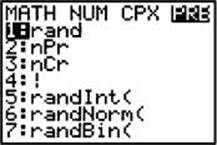SAT SUBJECT TEST MATH LEVEL 2
PART 2
![]()
REVIEW OF MAJOR TOPICS
![]()
CHAPTER 3
Numbers and Operations

3.1 Counting
![]()
FACTORIAL, PERMUTATIONS, COMBINATIONS
Counting problems like the ones in the last three examples occur frequently enough that they have special designations.
Ordering n Objects (Factorial)
The second example of the multiplication rule asked for the number of ways 6 friends could stand in line. By using the multiplication principle, we found that there were 6 ![]() 5
5 ![]() 4
4 ![]() 3
3 ![]() 2
2 ![]() 1 ways. A special notation for this product is 6! (6 factorial). In general, the number of ways objects can be ordered is n !
1 ways. A special notation for this product is 6! (6 factorial). In general, the number of ways objects can be ordered is n !
Ordering r of n Objects (Permutations)
The third example of the multiplication rule asked for the number of ways you could choose a first (president), second (vice president), and third person (secretary) out of 20 people (r = 3, n = 20). The answer is 20 ![]() 19
19 ![]() 18, or
18, or ![]() . In general, there are
. In general, there are ![]() permutations of robjects of n . This appears as nPr in the calculator menu.
permutations of robjects of n . This appears as nPr in the calculator menu.
Choosing r of n Objects (Combinations)
In the fourth example of the multiplication rule, we were interested in choosing a committee of 3 where there was no distinction among committee members. Our approach was first to compute the number of ways of choosing officers and then dividing out the number of ways the three officers could hold the different offices. This led to the computation ![]() . In general, the number of ways of choosing r of n objects is
. In general, the number of ways of choosing r of n objects is ![]() . This quantity appears on the calculator menu as nCr. However, there is a special notation for combinations:
. This quantity appears on the calculator menu as nCr. However, there is a special notation for combinations: ![]() the number of ways r objects can be chosen from n .
the number of ways r objects can be chosen from n .
Calculator commands for all three of these functions are in the MATH/PRB menu.

These 3 commands can also be found on scientific calculators.
EXERCISES
1. How many 3-person committees can be selected from a fraternity with 25 members?
(A) 15,625
(B) 13,800
(C) 2,300
(D) 75
(E) 8
2. A basketball team has 5 centers, 9 guards, and 13 forwards. Of these, 1 center, 2 guards, and 2 forwards start a game. How many possible starting teams can a coach put on the floor?
(A) 56,160
(B) 14,040
(C) 585
(D) 197
(E) 27
3. Five boys and 6 girls would like to serve on the homecoming court, which will consist of 2 boys and 2 girls. How many different homecoming courts are possible?
(A) 30
(B) 61
(C) 150
(D) 900
(E) 2048
4. In a plane there are 8 points, no three of which are collinear. How many lines do the points determine?
(A) 7
(B) 16
(C) 28
(D) 36
(E) 64
5. If ![]() , then x =
, then x =
(A) 0
(B) 1
(C) 4
(D) 5
(E) 10